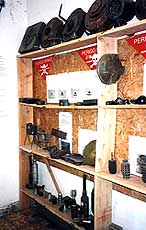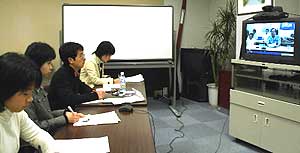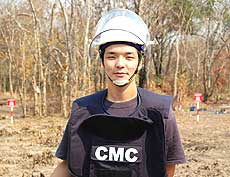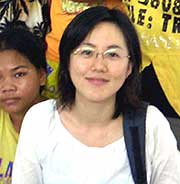Tragic explosions persist
Abolish all landmines
 |
Every day, about 40 people are injured or killed in landmine explosions around the world. Some children are injured as they play in their neighborhoods. Other children are killed by old landmines that were buried before they were even born. There are so many children who cannot play freely due to the fear of stepping on hidden landmines.
The International Campaign to Ban Landmines (ICBL), a network of more than 1400 organizations from 90 countries and regions, estimated that there were 26,000 victims a year prior to 2001. Although there are still many victims, the number has been decreasing through the efforts of private organizations to remove landmines in the affected countries.
This year is the 10th anniversary of the Mine Ban Treaty. For this issue, the junior writers spoke with a girl from Cambodia who was the victim of a landmine explosion. We also investigated the countries that suffer from landmines and we pondered how children can make a difference in improving this situation. As a result, we now feel deeply for the victims and we're determined to take action.
|
Picture: Various kinds of landmines removed in Angola by a British NGO. Landmines are classified into two general types: anti-tank mines and anti-personnel mines. Each mine contains a device designed to explode when triggered and some are even shaped like toys. In all, there are more than 300 kinds of landmines. |
Victims were found in 65 countries and regions in 2005-2006, numbering over 40 victims a day

According to the ICBL, there were landmine victims in 65 countries and regions in 2005-2006. Most explosions occurred in Asia and Africa.
The first landmines were reportedly used in the American Civil War (1861-1865) and, since that time, landmines have claimed a large number of victims throughout the world. A UN document in 1997 estimated the number of landmines at 110 million in 68 countries. But, in fact, we cannot know the real figure with any accuracy.
The ICBL estimates that there are 15,000-20,000 victims each year from landmines that remain buried after conflicts have ended. And at least three countries-Myanmar, Nepal, and Russia-continue to bury landmines today.
To resolve these problems with landmines, the Mine Ban Treaty was created in 1997 and came into effect in 1999. As of March 2007, 153 countries, including Japan, have ratified this document. At the same time, however, more than 1/5 of the countries in the world haven't yet ratified it. (Yutaro, Honkawa, 17)
I lost my brother and my leg -Song Kosal in Cambodia

What can we do to remove all landmines from the earth? Song Kosal has pondered the enduring damage caused by Cambodia's civil war which ended 16 years ago. After losing her brother and her leg, she now calls on the cooperation of children to help rid the world of landmines. We spoke with her in Phnom Penh through a video link arranged by Japan International Cooperation Agency (JICA).
 |
Junior writers speaking with Song Kosal (left, in the monitor) and Mr. Yaginuma (right, in the monitor) at the JICA office in Cambodia. Photo taken at Hiroshima International Plaza by Masahiro Mikoshi, 14. |
In 1989, when Song was five years old, she triggered a landmine when she was collecting firewood with her mother. And her older brother died when he stepped on another landmine.
She became depressed after losing her leg and stopped playing with her friends. Finally, though, when she was 12 years old, she began speaking out in public in the hope of preventing more landmine victims both inside and outside her country. She now campaigns for the ratification of the Mine Ban Treaty.
In 1998, she supported the "Youth Against War Treaty" campaign, aimed at the realization of a landmine-free world. She collected signatures to urge more countries to ratify the Mine Ban Treaty and helped create stronger momentum for this movement. (Kyoko Niiyama, 17)
Hoping for safe land in the future - JICA expert, Ryoji Yaginuma
We also talked with JICA expert Ryoji Yaginuma who supported the video conference. He works as a consultant at Cambodia Mine Action Center (CMAC).
In 2006, from 52% of the land where Cambodian mine-removal organizations were working, CMAC itself removed 36,807 landmines. However, it is believed that there are a total of 4-6 million landmines still buried in Cambodia. Mr. Yaginuma says, "I have no idea how long it will take to remove them all."
In January 2007, seven members of CMAC were killed in an accident while removing landmines. "We have to avoid future tragedies by learning from this accident," he says. "It is the hope of all people who are engaged in removing landmines to return the land to a safe state for future generations." (Minako Iwata, 13)
Click to view our video conference with Song.
34 countries have over 150 million landmines
Supporting the Mine Ban Treaty
Researching the removal of landmines, we found that the most common method is to locate the buried mines by using landmine detectors and special landmine dogs that can smell gunpowder. Then the mines are dug up by hand.
There are also some landmine removal machines that have been fashioned from bulldozers and graders. These machines have certain devices that can pound on the land in order to explode mines, but they cannot effectively be used for all landmines.
And so, in 2005, Hiroshima prefecture tried to develop another method: detecting landmines from a small unmanned helicopter through the use of an infrared camera and a metal detector. It was intended as Hiroshima prefecture's contribution to peace and could inspire other businesses and agencies to invent more new machines. However, when the prefecture couldn't obtain enough financial support from the central government, the project had to be postponed.
At the same time, professor Kenzo Nonami is working on a robot that can detect landmines. He remarked, however, "It's difficult to make practical use of this robot due to many obstacles, such as the training of engineers to perform maintenance work."
"No more landmines." We heard this simple and powerful message from many landmine victims and they have inspired us to take action.
According to the Japan Campaign to Ban Landmines (JCBL), as of March 2007 more than 150 million landmines are now stockpiled in 34 countries. Japan has already destroyed its landmines except for a limited number used for training purposes. The JCBL is now urging reluctant countries to ratify the Mine Ban Treaty through their "One Flap, Global Impact" campaign.
We promised Song that we would take part in this campaign-and we call on our friends, too-to help eradicate landmines from the earth. To join us, please visit the JCBL website. http://www17.big.or.jp/~r-net/Jirai-Haizetu/cyou-campaign/cyou-sozai-01.htm (Rikako Okada, 16)

Speaking with victims and supporters by e-mail
We sent e-mail to two Cambodian teenagers, Com Lick (14) and Kim Srey Chea (18) to learn more about the damage caused by landmines. We'll share their replies, along with two Japanese supporters.
Both boys stepped on landmines when they were 7 years old. In Com's case, when he jumped from a tree, and in Kim's case, when he was gathering firewood. As a result of these landmine explosions, Com lost half of his right leg and Kim lost half of his left leg.
Although Cambodia and Japan are both in Asia, we were shocked at the difference between our worlds as we live in a country without landmines. (Masahiro Mikoshi, 14)
Reply from Com Lick
 |
| Com Lick now wears an artificial leg.(photo by CMC) |
Q Could you tell us your name and where you live?
A My name is Com Lick and I'm 14 years old. My parents live in Ratanak Mondol in Batdambang state, but I live in a children's home called "Enfants du ekong" in Banteay Meanchey.
Q When was the landmine accident? How old were you? What were you doing at the time?
A I was 7 years old. In April 2000, I was picking nuts from a tree with two friends. When I jumped down from the tree, there was a landmine buried under the ground and it exploded.
Q How were you hurt by the landmine?
A The lower part of my right leg had to be amputated and my left leg was burned.
Q Who has been supporting you since the accident? What words have encouraged you?
A The woman at the children's home (who takes care of 14 other children, too) has supported me a lot. She tells me, "Don't be depressed. You can overcome the difficulties. Study hard and do your best for other people."
Reply from Yuya Yoshimi, support staff for the Cambodia Mine- Removal Campaign, an NGO

Q What kind of work are you doing in Cambodia?
A Our office is located in Batdambang, close to the Thai border, where many landmine accidents occur. We broadcast a radio program called "Voice of Heart" to support victims and warn residents of the danger of landmines. We also run an elementary school built by CMC.
Q I imagine you face many challenges, especially in providing support to the victims.
A Landmine victims struggle emotionally, too. It's not just the physical injuries, the emotional trauma is real-such as the discrimination they sometimes experience. It's very hard to get these people to open up. So we try to respect their feelings-we don't force them to talk.
Q Are the people of Cambodia really aware of the danger of landmines?
A Most adults understand that landmines are explosives. And at elementary school, they teach the children to avoid landmines. However, some people don't really comprehend how powerful landmines are and how dangerous they are to touch. Young children, especially, cannot understand the danger.
Q Have your thoughts about the landmine issue changed since you came to Cambodia?
A Since I started working here, I have gradually grown to understand the reality of the problem. For instance, despite the danger of buried landmines, they have to cultivate their fields because there is no other way to earn income. And children who are too poor to go to school cannot learn about the danger of landmines.
Q Do you have any suggestions as to how the youth of Japan can support these people?
A First, do the very best you can in your own life and live it to the fullest. You will then have more energy and hope and love to share with others and that can encourage them in their efforts. Also, I think it's important to see them as equals, not just as "victims."
Reply from Kim Srey Chea
 |
Kim taking a lesson at school (in the front). |
Q Can we have your name and birthday? Where do you live now?
A My name is Kim Srey Chea. I was born on October 15, 1988, and I used to live in Kampong Som with my grandmother. Now I live in the dormitory of a vocational training school in Phnom Penh. My mother left me when I was one month old.
Q How old were you when you encountered the landmine? What happened?
A I was seven years old. I was collecting firewood in the forest. As I pulled a tree branch from a bush, I stepped on the landmine.
Q Where were you injured ?
A My left leg had to be amputated below the knee. I felt no hope for my life until I come to the vocational training school.
Q What kind of activities are you doing at your school?
A I am learning to sew bags, which I like very much. I practice sewing six hours a day, Monday to Friday. In addition, I study reading and writing an hour each day. Also, once a month, I attend lessons on the rights of the disabled. And twice a month I can enjoy various student activities. So I'm learning many interesting and useful things and I like my school very much.
Q To help abolish landmines, we think it might be useful to exchange ideas between youth in countries with landmine victims and youth in other countries. And we make a pledge, which grows around the world, never to use landmines in the future. Please tell us what you think.
A To abolish landmines from the world, we must appeal to countries that manufacture them so no more mines will be made.
Reply from Michiyo Kato of Association for Aid and Relief (AAR) JAPAN, the NGO which founded the vocational training school Kim goes to

Q We heard you were in Cambodia from August 2005 to June 2006. What kind of work were you doing ?
A I was in charge of coordinating skills training for the disabled as well as the manufacture and distribution of wheelchairs. These two projects had been managed mainly by Japanese staff, so I supported their handover to Cambodian staff.
Q To what extent is there awareness about landmines among the people?
A Landmine education has been effective, but it's hard to measure how widespread the impact is. Of course, this education is important, but it's also important to improve the social and economic factors that drive the people to work in dangerous locations.
Q After completing skills training, what kinds of jobs do the students generally get?
A We teaching sewing, repairing electrical appliances, and fixing bicycles, so these are the jobs they usually do.
Q What can the youth of Japan do to support these people?
A You're still students so you needn't be in a hurry, but I suggest you practice empathy for other people's feelings and think for yourself with your own mind.
- International Campaign to Ban Landmines (ICBL)
The international network of NGOs that aims to abolish landmines. In 1997, ICBL received the Nobel Peace Prize for their contribution to the Mine Ban Treaty.
- The Mine Ban Treaty
The treaty intended to ban the production and use of landmines. It was initiated in December 1997 in Ottawa, Canada. As of March 2007, about 80% of all countries and regions have ratified it.
